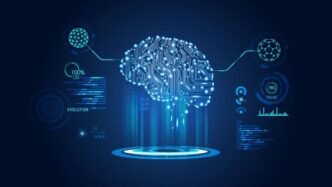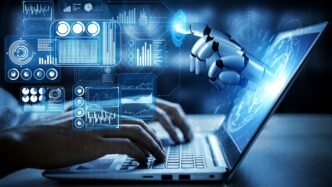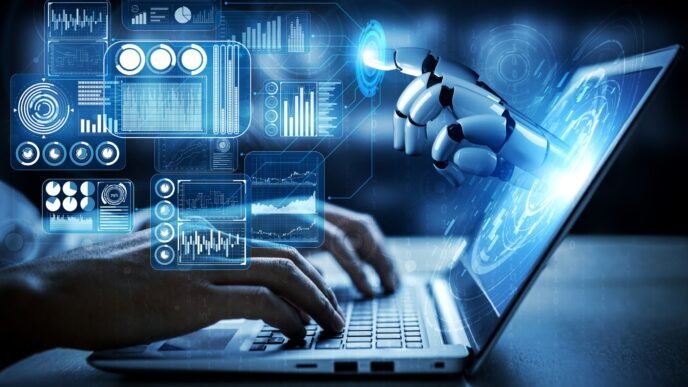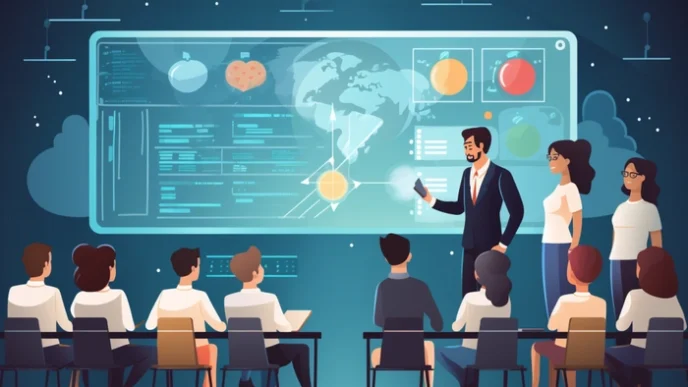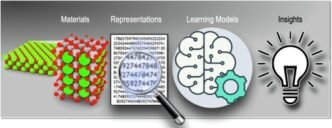Introduction
In the era of digital transformation, Adaptive Learning powered by Artificial Intelligence (AI) is revolutionizing the way we acquire knowledge and skills. This innovative approach tailors educational experiences to individual learners’ needs, preferences, and performance in real-time. By leveraging AI algorithms, adaptive learning systems can dynamically adjust content, pacing, and learning paths, providing a personalized journey that enhances engagement and efficacy.
This blog explores what adaptive learning is, how it benefits various sectors, the technical advancements propelling it forward, potential challenges, and its broader impact on industries and society.
What Is Adaptive Learning?
Adaptive learning is an educational method that uses computer algorithms to orchestrate the interaction with learners and deliver customized resources and learning activities to address each individual’s unique needs. It relies on data analysis to adjust the path and pace of learning, ensuring that learners receive the most relevant and effective instruction.
Key Features:
• Personalization: Tailors content to the learner’s knowledge level, skills, and learning style.
• Real-Time Feedback: Provides immediate insights into performance, allowing for prompt adjustments.
• Dynamic Content Delivery: Adjusts difficulty and topics based on learner interactions.
• Data-Driven Insights: Utilizes analytics to inform instructional strategies and improve learning outcomes.
Example: An adaptive learning platform might present more challenging problems to a student who excels in a particular area while offering additional support and resources to another student struggling with the same topic.
How Adaptive Learning Helps
Adaptive learning systems offer numerous benefits to learners, educators, and organizations by enhancing the learning experience and outcomes.
For Learners
• Enhanced Engagement: Personalized content keeps learners motivated and interested.
• Improved Retention: By focusing on areas that need improvement, learners can grasp concepts more effectively.
• Flexible Learning Paths: Allows learners to progress at their own pace, accommodating different learning speeds.
• Accessibility: Provides tailored support for learners with diverse needs, including those with disabilities.
For Educators
• Efficient Resource Allocation: Helps teachers identify where to focus their efforts based on individual student needs.
• Data-Driven Decision Making: Offers insights into class performance and areas requiring intervention.
• Scalability: Enables educators to manage larger groups without compromising on personalized attention.
For Organizations
• Workforce Development: In corporate training, adaptive learning enhances employee skills efficiently.
• Cost Reduction: Streamlines training processes, reducing time and resources spent on ineffective methods.
• Compliance Training: Ensures that all employees meet required standards and regulations through personalized modules.
Case Study: Language learning apps like Duolingo use adaptive algorithms to adjust lesson difficulty, helping users learn new languages more effectively by focusing on their weak points.
Technical Advancements in Adaptive Learning
The evolution of adaptive learning is closely tied to advancements in AI and related technologies.
Artificial Intelligence and Machine Learning
• Algorithms and Models: Machine learning models analyze learner data to predict performance and adjust content.
• Natural Language Processing (NLP): Enables understanding and generation of human language, enhancing interactions in learning platforms.
• Predictive Analytics: Anticipates learner needs and potential challenges to proactively adjust learning paths.
Big Data and Analytics
• Data Collection: Massive amounts of data from learner interactions are collected for analysis.
• Real-Time Processing: Immediate data processing allows for on-the-fly adjustments to learning materials.
Cloud Computing
• Scalability: Cloud platforms enable adaptive learning systems to handle large numbers of users.
• Accessibility: Learners can access content anytime, anywhere, facilitating continuous learning.
User Experience (UX) Design
• Intuitive Interfaces: User-friendly designs improve engagement and ease of use.
• Interactive Content: Multimedia elements like videos, quizzes, and simulations enhance the learning experience.
Integration with Other Technologies
• Virtual Reality (VR) and Augmented Reality (AR): Create immersive learning environments for hands-on experiences.
• Internet of Things (IoT): Devices collect data on learner behavior in physical spaces, further personalizing learning.
Sectors Boosted by Adaptive Learning
Adaptive learning is making significant impacts across various industries beyond traditional education.
Education
• K-12 Schools: Personalized learning plans help students achieve academic success.
• Higher Education: Universities implement adaptive platforms to support diverse student populations.
• Online Learning Platforms: MOOCs (Massive Open Online Courses) utilize adaptive learning to cater to global learners.
Corporate Training
• Employee Onboarding: Tailored training accelerates the integration of new hires.
• Skill Development: Continuous learning keeps employees up-to-date with industry trends.
• Leadership Training: Adaptive modules prepare future leaders with customized development plans.
Healthcare
• Medical Education: Adaptive learning aids in training healthcare professionals with up-to-date practices.
• Patient Education: Personalized information helps patients understand their health conditions and treatments.
Military and Defense
• Simulation Training: Adaptive systems adjust scenarios based on trainee performance for effective preparedness.
• Skill Retention: Continuous, personalized training ensures skills remain sharp over time.
Technology and IT
• Certification Preparation: IT professionals use adaptive learning to prepare for certifications like AWS or Cisco.
• Product Training: Tech companies train users on new software or updates through personalized modules.
Retail and Customer Service
• Sales Training: Adaptive learning helps staff master product knowledge and sales techniques.
• Customer Interaction: Personalized training improves customer service skills and client satisfaction.
Potential Harms and Challenges
While adaptive learning offers many advantages, it also presents challenges and potential drawbacks.
Data Privacy Concerns
• Sensitive Information: Collection of personal data raises concerns about how information is stored and used.
• Regulatory Compliance: Organizations must adhere to laws like GDPR to protect learner data.
Over-Reliance on Technology
• Reduced Human Interaction: Excessive dependence on technology may diminish valuable teacher-student relationships.
• Technical Issues: System failures or glitches can disrupt the learning process.
Equity and Access
• Digital Divide: Learners without access to necessary technology or internet connectivity may be left behind.
• Cost Barriers: High-quality adaptive learning platforms may be expensive for some institutions or individuals.
Algorithmic Bias
• Unintended Discrimination: Biases in algorithms can lead to unequal learning opportunities.
• Transparency Issues: Lack of understanding of how decisions are made within the system can hinder trust.
Resistance to Change
• Institutional Inertia: Educational institutions may resist adopting new technologies due to tradition or skepticism.
• Training Requirements: Educators need training to effectively implement and use adaptive learning systems.
Content Quality
• Standardization: Ensuring consistent and accurate content across adaptive platforms can be challenging.
• Localization: Adapting content for different cultures, languages, and contexts requires significant effort.
Example: If an adaptive learning system misinterprets a student’s needs due to flawed data or biases, it might direct them away from beneficial content, hindering their progress.
Conclusion
Adaptive learning represents a significant leap forward in personalizing education and training across various sectors. By leveraging AI and technological advancements, it offers tailored experiences that enhance learning outcomes, engagement, and efficiency.
However, it’s essential to navigate the challenges carefully. Addressing data privacy concerns, ensuring equitable access, mitigating biases, and maintaining the human element in education are critical for the responsible implementation of adaptive learning systems.
As technology continues to evolve, adaptive learning has the potential to democratize education, making high-quality, personalized learning accessible to all. By embracing innovation while remaining vigilant about potential pitfalls, we can harness the full power of adaptive learning to transform education and beyond.
Key Takeaways:
• Adaptive Learning Defined: An AI-driven approach that personalizes education to individual learner needs.
• Benefits: Enhances engagement, improves retention, supports educators, and optimizes organizational training.
• Technical Advancements: AI, machine learning, big data, cloud computing, and UX design propel adaptive learning forward.
• Industry Impact: Significant benefits observed in education, corporate training, healthcare, military, and more.
• Challenges: Data privacy, over-reliance on technology, equity issues, algorithmic bias, and resistance to change.
• Future Outlook: With mindful implementation, adaptive learning can revolutionize how we learn and grow in various facets of life.
By staying informed and proactive, educators, organizations, and learners can work together to maximize the benefits of adaptive learning while mitigating its risks. The journey toward a more personalized and effective learning experience is well underway, promising a future where education adapts to the learner, not the other way around.
